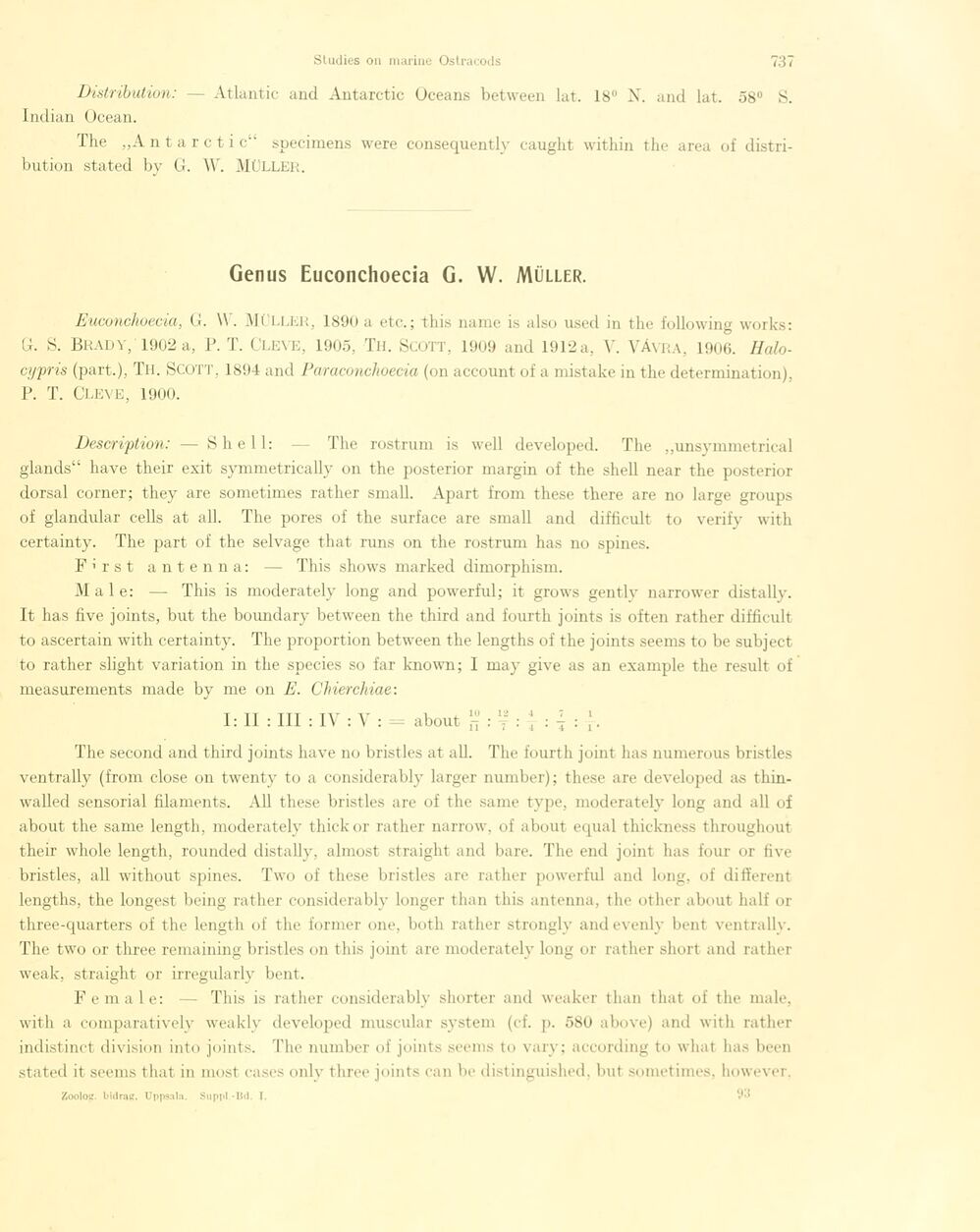
Full resolution (JPEG) - On this page / på denna sida - Sidor ...

<< prev. page << föreg. sida << >> nästa sida >> next page >>
Below is the raw OCR text
from the above scanned image.
Do you see an error? Proofread the page now!
Här nedan syns maskintolkade texten från faksimilbilden ovan.
Ser du något fel? Korrekturläs sidan nu!
This page has never been proofread. / Denna sida har aldrig korrekturlästs.
Distribution: — Atlantic and Antarctic Oceans between lat, 18° N. and lat. 58° S.
Indian Ocean.
The „A n t a r c t i c“ speciraens were consequently cauglit within the area of
distribution stated by G. W. MULLER.
Genus Euconchoecia G. W. Müller.
Euconchoecia, G. W. Müller, 1890 a etc.; this name is also used in the foUowing Works:
G. S. Brady, 1902 a, P. T. CLEVE, 1905, Th. SCOTT, 1909 and 1912 a, V. Vàyra, 1906.
Halo-cypris (part.), Tu. SCOTT, 1894 and Paraconchoecia (on account of a mistake in the determination),
P. T. Cleve, 1900.
Description: — Shell: — The rostrum is well developed. The „unsymmetrical
glands“ have their exit synimetrically on the posterior margin of the shell near the posterior
dorsal corner; they are sometimes rather small. Apart from these there are no large groups
of glandular cells at all. The pores of the surface are small and difficult to verify with
certainty. The part of the selvage that runs on the rostrum has no spines.
F’r st antenna: — This shows marked dimorphism.
Male: — This is moderately long and powerful; it grows gently narrower distally.
It has five joints, but the boundary between the third and fourth joints is often rather difficult
to ascertain with certainty. The proportion between the lengths of the joints seems to be subject
to rather slight variation in the species so far known; I may give as an example the result of
measurements made by me on E. Chierchiae:
I: II : III : IV : V
about J-)’ : j
1
1 *
The second and third joints have no bristles at all. The fourth joint has numerous bristles
ven trally (from close on twenty to a considerably larger number); these are developed as
thin-walled sensorial filaments. All these bristles are of the same type, moderately long and all of
about the same length, moderately thickor rather narrow, of about equal thickness throughout
their whole length, rounded distally, almost straight and bare. The end joint has four or five
bristles, all without spines. Two of these bristles are rather powerful and long, of different
lengths, the longest being rather considerably longer than this antenna, the other about half or
three-quarters of the length of the former one, both rather strongly and evenly bent ventrally.
The two or three remaining bristles on this joint are moderately long or rather short and rather
weak, straight or irregularly bent.
Female: — This is rather considerably shorter and weaker than that of the male,
with a comparatively weaklv developed muscular system (cf. p. 580 above) and with rather
indistinct division into joints. The number of joints seems to vary; according to what has been
stated it seems that in most cases only three joints can be distinguished, but sometimes, however.
£oolop. bidrap. Uppsala. Suppl -13(1. T. ^
<< prev. page << föreg. sida << >> nästa sida >> next page >>